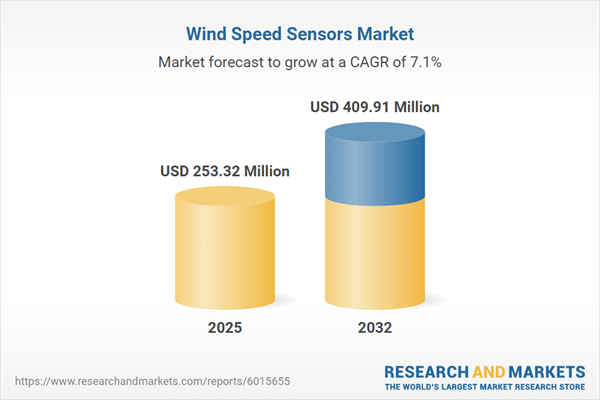Speak directly to the analyst to clarify any post sales queries you may have.
Market Snapshot: Wind Speed Sensors Market Performance and Growth Prospects
The wind speed sensors market grew from USD 236.45 million in 2024 to USD 253.32 million in 2025. It is projected to reach USD 409.91 million by 2032 with a CAGR of 7.11%. Growth is attributed to increased adoption in renewable energy, research, and meteorological applications, as well as a global trend toward robust, networked environmental monitoring systems. Stakeholders across energy, research, meteorology, and infrastructure sectors rely on precise and timely wind speed data to improve operational efficiency and compliance with emerging environmental standards.Scope & Segmentation of the Wind Speed Sensors Market
This research report provides in-depth analysis and forecasting of the wind speed sensors market, examining major segments and sub-markets with a clear focus on strategic drivers and end-user priorities.- Product Types: Cup Anemometer, Hot Wire Anemometer, Laser Doppler, Ultrasonic (Three Dimensional, Two Dimensional), and Vane Anemometer
- Applications: Meteorology (Research Facilities, Weather Stations), Research (Academic Institutions, Government Agencies), Wind Energy (Offshore Wind Farms, Onshore Wind Farms)
- Installation Locations: Offshore, Onshore
- End Users: Commercial (Building Automation, Heating Ventilation Air Conditioning), Industrial (Manufacturing, Oil and Gas, Power Generation), Residential (Personal Weather Stations, Smart Home), Utility
- Connectivity Protocols: Wired (4-20 Milliamp, Modbus), Wireless (Bluetooth, LoRaWAN, Wi-Fi, Zigbee)
- Regional Scope: Americas (North America, Latin America), Europe, Middle East & Africa, Asia-Pacific
- Key Market Participants: Vaisala Oyj, Campbell Scientific, Inc., Thies Clima GmbH & Co. KG, Gill Instruments Limited, R.M. Young Company, G. Lufft GmbH, NRG Systems, Inc., Airmar Technology Corporation, Met One Instruments, Inc., E+E Elektronik Ges.m.b.H.
Key Takeaways for Senior Decision-Makers
- Advanced sensor technologies such as ultrasonic and laser Doppler solutions are reshaping accuracy standards and supporting integrated, multi-functional deployments across diverse environments.
- IoT and cloud connectivity are enabling predictive maintenance programs, which reduce costs and drive higher asset reliability for users in industrial and utility segments.
- Regional policy drivers, especially in the Americas and Asia-Pacific, are accelerating sensor adoption in renewable energy initiatives and disaster response systems.
- Product modularity and compatibility with evolving connectivity protocols allow for agile adaptation to regulatory requirements and operational needs.
- Collaborations between manufacturers, research institutions, and local assembly partners are fostering sector innovation and enhanced regional market access.
Tariff Impact: Navigating United States Trade Measures
The implementation of new tariff measures by the United States in 2025 has influenced supply chains for wind speed sensors, driving manufacturers to consider alternatives such as domestic sourcing or localized assembly. These responses aim to manage input costs and reduce import-related risks, while supporting greater investment in local R&D and more resilient production ecosystems. Alignment with government certification initiatives and supply chain incentives is now central to sustaining competitive market positions.Methodology & Data Sources
The analysis is grounded in a multi-phase methodology, including secondary research from reputable scientific and technical publications, supplemented by primary interviews with industry experts and key market participants. Robust data triangulation and validation ensure accurate, actionable conclusions. Expert advisory review further enhances objectivity and market relevance.Why This Report Matters
- Enables leaders to benchmark evolving technology adoption and connectivity integrations within their strategic framework.
- Equips senior managers to anticipate regulatory shifts and supply chain disruptions in crucial markets.
- Facilitates targeted investment decisions by clarifying end-user and regional demand dynamics.
Conclusion
As technological refinement and regulatory change reshape the wind speed sensors market, informed strategy and agile execution are essential. This report supports executive decision-making in an increasingly interconnected and competitive ecosystem.
Additional Product Information:
- Purchase of this report includes 1 year online access with quarterly updates.
- This report can be updated on request. Please contact our Customer Experience team using the Ask a Question widget on our website.
Table of Contents
3. Executive Summary
4. Market Overview
7. Cumulative Impact of Artificial Intelligence 2025
Companies Mentioned
The companies profiled in this Wind Speed Sensors market report include:- Vaisala Oyj
- Campbell Scientific, Inc.
- Thies Clima GmbH & Co. KG
- Gill Instruments Limited
- R.M. Young Company
- G. Lufft GmbH
- NRG Systems, Inc.
- Airmar Technology Corporation
- Met One Instruments, Inc.
- E+E Elektronik Ges.m.b.H.
Table Information
| Report Attribute | Details |
|---|---|
| No. of Pages | 199 |
| Published | October 2025 |
| Forecast Period | 2025 - 2032 |
| Estimated Market Value ( USD | $ 253.32 Million |
| Forecasted Market Value ( USD | $ 409.91 Million |
| Compound Annual Growth Rate | 7.1% |
| Regions Covered | Global |
| No. of Companies Mentioned | 11 |









